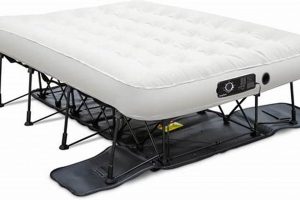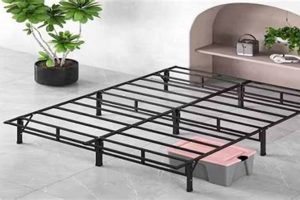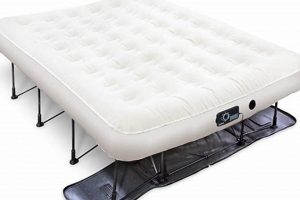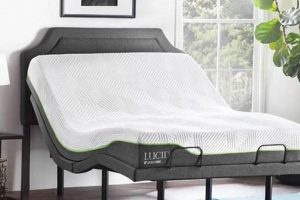A full-size mattress is designed with dimensions significantly smaller than those of a queen-size bed frame. Attempting to place a full-size mattress within a queen-size frame will result in substantial gaps around the perimeter of the mattress. This dimensional mismatch prevents adequate support for the mattress and can lead to instability and potential damage to both the mattress and the frame.
Understanding mattress and bed frame size compatibility is crucial for ensuring proper sleep support, structural integrity, and overall comfort. Historically, standardized mattress sizes have evolved to accommodate varying needs and bedroom dimensions. Selecting correctly sized components avoids potential safety hazards and optimizes the lifespan of the bedding.
The primary considerations when choosing a mattress and bed frame are their respective dimensions and intended use. Further discussion will delve into the specific consequences of size discrepancies and alternative solutions when faced with mismatched components.
Considerations Regarding Bed Frame and Mattress Compatibility
The following recommendations address the issue of dimensional incompatibility between mattress and bed frame sizes. Adhering to these points promotes both safety and optimal comfort.
Tip 1: Measure Dimensions. Prior to purchase, obtain precise measurements of both the mattress and the bed frame. Verify that the dimensions align with established industry standards for the intended size category.
Tip 2: Assess Structural Support. A mattress that does not fully occupy the bed frame is susceptible to uneven wear and tear. Evaluate the slat spacing and overall frame construction to ensure sufficient support for the mattress type being used.
Tip 3: Acknowledge Safety Concerns. Gaps between the mattress and the frame can create tripping hazards and potential entrapment zones, particularly for children or pets. Mitigate these risks by selecting appropriately sized components.
Tip 4: Explore Adapter Solutions. While not ideal, certain adapter solutions may temporarily address minor size discrepancies. Research readily available gap fillers, platform extensions, or custom-built supports to compensate for the difference. However, the long term is not recommended.
Tip 5: Prioritize Intended Use. The intended use of the bed, be it for occasional use in a guest room or nightly sleep for a primary resident, should influence the decision-making process when resolving size mismatch. Occasional or short term uses might tolerate a compromise on perfect fit better.
Tip 6: Evaluate Cost Implications. Factor in the potential cost of damage to both the mattress and the bed frame resulting from improper fitting. The cost of replacement might outweigh the short-term savings of using mismatched components.
The adoption of these guidelines contributes to a safer, more comfortable, and structurally sound sleep environment. Proper alignment of components ensures that the investment in both the mattress and bed frame is fully realized.
The subsequent sections will address related issues in achieving optimal sleep ergonomics and maximizing the lifespan of bedding.
1. Incompatible Dimensions
Incompatible dimensions constitute the primary reason why a full-size mattress cannot be effectively utilized with a queen-size bed frame. A full-size mattress, also known as a double mattress, typically measures 54 inches wide and 75 inches long. In contrast, a queen-size mattress measures 60 inches wide and 80 inches long. This dimensional disparity results in a six-inch width difference and a five-inch length difference between the two mattress sizes. The resultant gaps, when a smaller mattress is placed within a larger frame, negate the intended support structure.
The ramifications of ignoring these dimensional discrepancies are significant. Without proper edge support, the mattress can shift within the frame, leading to uneven weight distribution and accelerated wear. For example, individuals consistently sleeping near the edge of a full-size mattress on a queen frame may experience premature sagging and a reduced lifespan for the mattress. Moreover, the exposed gaps introduce potential safety hazards. Children and pets may become trapped between the mattress and the frame, creating a risk of injury. A mis-sized mattress also eliminates intended aesthetic alignment with the bed frame. An inappropriate fit undermines the visual appeal of the bedroom furniture.
In conclusion, acknowledging the dimensional differences between full and queen-size mattresses is vital for selecting appropriate bedding. Failure to adhere to established size standards results in compromised support, potential safety risks, accelerated wear, and reduced overall value. Proper mattress and frame matching ensures both user safety and optimizes the long-term performance of the sleep system.
2. Structural Instability
Structural instability arises as a direct consequence of attempting to accommodate a full-size mattress within a queen-size bed frame. The significant dimensional disparity creates an unsupported periphery, undermining the intended stability of the sleep system.
- Compromised Edge Support
A full-size mattress placed on a queen-size frame will exhibit a lack of edge support along all sides. The frame’s structural members are designed to support the specific dimensions of a queen-size mattress. The absence of this support results in an unstable perimeter, potentially leading to mattress sagging and an increased risk of rolling off the bed. This phenomenon is particularly pronounced for individuals who frequently sleep near the edges of the mattress.
- Uneven Weight Distribution
Queen-size frames are engineered to distribute weight evenly across the entire surface of a queen-size mattress. When a smaller full-size mattress is used, the weight becomes concentrated in the central area, leaving the edges unsupported. This uneven distribution places undue stress on the mattress core and can accelerate the deterioration of internal components, such as springs or foam layers. The frame itself can also be subject to increased strain in specific areas, potentially leading to structural damage over time.
- Increased Risk of Frame Damage
The inherent structural imbalance can extend to the bed frame itself. The frame’s structural integrity relies on the uniform distribution of weight across its entire surface. Using a smaller mattress creates localized stress points, particularly at the corners. Over time, this stress can result in warping, bending, or even breakage of frame components. The impact is amplified for frames constructed from less robust materials, such as inexpensive wood or lightweight metal.
- Reduced Motion Isolation
One benefit of a properly sized mattress and bed frame is the proper motion isolation. Movement on one side of the bed will be felt less on the other. When the frame is much bigger, with a gap on each side, it allows much greater movement, decreasing the motion isolation. A good nights sleep requires minimizing interruptions from others.
The absence of a secure fit between the mattress and the frame generates a structurally unsound sleep environment. The instability not only compromises comfort but also accelerates the wear and tear of both the mattress and the frame. Addressing the fundamental issue of dimensional incompatibility is essential to ensure long-term structural integrity and user safety.
3. Compromised Support
The issue of compromised support is a direct and detrimental consequence of attempting to utilize a full-size mattress with a queen-size bed frame. This mismatch undermines the structural integrity of the sleep system and negatively impacts the user’s comfort and well-being.
- Inadequate Spinal Alignment
A mattress lacking sufficient support allows the spine to fall out of its natural alignment during sleep. The gaps created by the smaller mattress within the larger frame lead to inconsistent support across the body. Certain areas, particularly the lumbar region, may receive inadequate support, resulting in back pain and discomfort. Individuals may experience restless sleep as the body attempts to compensate for the lack of proper spinal alignment.
- Pressure Point Amplification
Without uniform support, pressure points are exacerbated. Areas such as the hips, shoulders, and knees bear a disproportionate amount of weight, leading to increased pressure and potential discomfort. This uneven weight distribution can disrupt blood circulation and contribute to the development of pressure sores over time. Reduced support negates any pressure-relieving properties of the mattress itself.
- Reduced Motion Isolation
The larger frame and gaps around the mattress intensify motion transfer. Movement on one side of the bed is more easily felt on the other, disrupting the sleep of a partner. The queen-size frame is designed to dampen movement across a queen-size mattress. The lack of full contact between the smaller mattress and the frame negates this intended motion isolation.
- Increased Risk of Sagging
Inadequate support accelerates mattress sagging. The unsupported edges of the full-size mattress within the queen-size frame become prone to premature wear and deformation. Consistent use of the mattress in this configuration compromises its structural integrity and reduces its lifespan. The sagging not only diminishes comfort but also further exacerbates issues of spinal alignment and pressure point amplification.
The compromised support resulting from this size mismatch directly undermines the essential functions of a quality sleep system. Proper spinal alignment, pressure point relief, and motion isolation are all negatively impacted, leading to discomfort, restless sleep, and potential long-term health consequences. Correctly matching mattress and frame sizes is essential for ensuring optimal support and maximizing the benefits of restorative sleep.
4. Potential Hazards
The incongruity of a full-size mattress placed within a queen-size bed frame introduces several potential hazards to the immediate environment. The dimensional mismatch creates gaps between the mattress and the frame, posing a risk of entrapment, particularly for children and pets. These gaps can become confined spaces where limbs can become lodged, potentially resulting in injury. Furthermore, the instability of the mattress can lead to unexpected shifting or collapse, increasing the risk of falls, particularly for individuals with mobility issues. The uneven support also amplifies the possibility of developing pressure sores due to concentrated weight distribution and inadequate cushioning.
Beyond the immediate physical risks, the dimensional disparity also presents a heightened fire hazard. The gaps between the mattress and the frame can accumulate dust and debris, creating a readily ignitable environment. Should a small spark or ember come into contact with this accumulated material, the resulting fire could spread rapidly, facilitated by the increased airflow within the open space. The placement of electrical devices near the bed, such as phone chargers or lamps, further increases the risk of ignition within this area.
In summary, utilizing mismatched mattress and frame sizes directly introduces potential hazards. Entrapment, falls, pressure sores, and increased fire risk are all significant concerns arising from this incompatibility. Acknowledging and mitigating these hazards through the proper selection of appropriately sized bedding components is essential for ensuring a safe and comfortable sleep environment. Prioritizing safety through proper matching of mattress and bed frame sizes is vital for reducing potential injuries and ensuring a secure sleep environment.
5. Reduced Comfort
The utilization of a full-size mattress within a queen-size bed frame invariably leads to reduced comfort. This arises from several interconnected factors, stemming directly from the dimensional mismatch. The full-size mattress, being smaller, lacks the necessary surface area to adequately fill the queen-size frame. This results in unsupported areas, typically around the perimeter of the mattress, which compromise the overall structural integrity of the sleep surface. The individual experiences a sensation of instability, particularly when positioned near the edge of the bed, as the absence of adequate support creates a noticeable sinking or collapsing effect. This instability disrupts sleep patterns and hinders the ability to achieve a restful state.
The compromised support resulting from this dimensional incompatibility also leads to uneven weight distribution across the mattress surface. Specific areas of the body, such as the hips and shoulders, may bear a disproportionate amount of weight, leading to increased pressure points and discomfort. This uneven distribution can further exacerbate issues such as back pain and stiffness. Real-life examples often involve individuals reporting a noticeable decline in sleep quality, marked by increased tossing and turning, and a general feeling of unrest upon waking. This stems directly from the body’s subconscious attempt to find a comfortable and stable position on the inadequately supported mattress.
In summary, the reduction in comfort resulting from employing a smaller mattress within a larger frame is a direct consequence of compromised support and uneven weight distribution. These factors conspire to disrupt sleep patterns, exacerbate existing discomfort, and ultimately detract from the overall quality of the sleep experience. Addressing this dimensional mismatch is crucial for prioritizing comfort and ensuring a restorative sleep environment.
6. Mattress Damage
Placing a full-size mattress on a queen-size bed frame introduces a range of potential damage mechanisms that can significantly reduce the lifespan and performance of the mattress. The absence of proper support, resulting from the dimensional mismatch, accelerates wear and tear, leading to various forms of degradation.
- Edge Collapse and Sagging
The edges of a full-size mattress, when positioned on a queen-size frame, lack the necessary support. This absence of support leads to accelerated edge collapse and sagging. The weight is not distributed evenly across the frame, causing the edges to bear a disproportionate load. Over time, the internal structure of the mattress weakens, resulting in a visible depression along the perimeter. This degradation not only compromises comfort but also reduces the usable sleep surface.
- Internal Structure Degradation
The uneven distribution of weight caused by the mismatched sizes places undue stress on the internal components of the mattress. Springs can become distorted or broken, foam layers can compress prematurely, and overall structural integrity is compromised. This internal degradation accelerates the aging process of the mattress, leading to reduced support and increased discomfort. The effect is amplified for mattresses constructed from lower-quality materials.
- Cover Stretching and Tearing
The movement and shifting of a full-size mattress within a queen-size frame can cause the mattress cover to stretch and tear. The cover is designed to fit snugly around the intended mattress size; the excess space within the queen-size frame allows for increased movement and friction, which abrades the cover material. Tears and stretching compromise the integrity of the cover, exposing the internal components to potential damage from dirt, moisture, and pests. This damage also increases the risk of allergens accumulating within the mattress.
- Voided Warranty Claims
Most mattress warranties specify that the mattress must be used with a properly sized and supportive bed frame. Using a full-size mattress on a queen-size frame constitutes improper use, which can void the warranty. In the event of premature mattress failure or damage, the manufacturer may deny warranty claims, leaving the consumer responsible for the cost of repair or replacement. Adhering to the specified usage guidelines is essential for preserving the validity of the warranty.
In summary, the dimensional incompatibility of a full-size mattress on a queen-size bed frame introduces a cascade of damage mechanisms. Edge collapse, internal structure degradation, cover stretching, and voided warranty claims all contribute to a shortened mattress lifespan and compromised sleep quality. Selecting appropriately sized components is crucial for maximizing the longevity and performance of the mattress.
Frequently Asked Questions
The following questions address common inquiries regarding the compatibility of full-size mattresses with queen-size bed frames, clarifying potential issues and outlining best practices.
Question 1: Is it physically possible to place a full-size mattress on a queen-size bed frame?
While a full-size mattress can be physically placed on a queen-size bed frame, the resulting dimensional disparity negates the intended support structure and compromises overall stability.
Question 2: What are the primary risks associated with using a smaller mattress on a larger frame?
Risks include compromised edge support, uneven weight distribution, accelerated mattress wear, potential entrapment hazards, and reduced comfort.
Question 3: Can gap fillers or adapters adequately compensate for the size difference?
While gap fillers or adapters may offer a temporary solution, they do not fully replicate the stability and support provided by a correctly sized mattress and frame combination. These are not considered long-term solutions.
Question 4: Will using a full-size mattress on a queen-size frame void the mattress warranty?
Most mattress warranties specify that the mattress must be used with a properly sized and supportive bed frame. Using mismatched components can void the warranty, leaving the consumer responsible for any potential damage or failure.
Question 5: Does this size mismatch affect the bed’s weight capacity?
Yes, the weight capacity may be affected. Queen-size frames are designed to distribute weight evenly across a queen-size mattress. Using a smaller mattress concentrates the weight in certain areas, potentially exceeding the frame’s localized weight limits.
Question 6: Are there any circumstances where this arrangement might be acceptable?
In very limited, short-term scenarios, such as temporary use in a guest room, the arrangement might be tolerated with careful consideration and mitigation of the aforementioned risks. However, this is not recommended for regular or long-term use.
Understanding the implications of using mismatched mattress and frame sizes is crucial for ensuring a safe, comfortable, and structurally sound sleep environment.
Further exploration of bedding options and size considerations will be addressed in the following section.
Conclusion
The preceding exploration clearly demonstrates that a full-size mattress is not designed to be used with a queen-size bed frame. The significant dimensional differences lead to compromised support, increased risk of damage to both the mattress and frame, and potential safety hazards. These factors negatively impact sleep quality and overall well-being.
Therefore, adhering to established size standards when selecting mattresses and bed frames is crucial. Prioritizing proper fit ensures optimal sleep support, structural integrity, and a safer sleep environment. Deviation from these standards introduces unnecessary risks and diminishes the long-term value of the bedding investment.




![Best Queen Futon Frame and Mattress Sets: [Year] Guide Organic & Natural Mattress Buyer’s Guide: Non-Toxic Sleep Solutions Best Queen Futon Frame and Mattress Sets: [Year] Guide | Organic & Natural Mattress Buyer’s Guide: Non-Toxic Sleep Solutions](https://mattressworldpa.com/wp-content/uploads/2025/07/th-3093-300x200.jpg)


